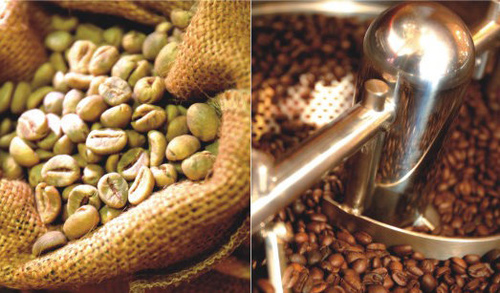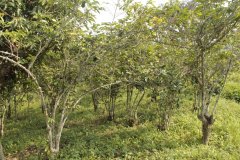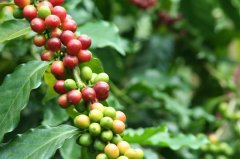Basic screening of Coffee beans: a National system for screening and grading of Coffee beans

For professional baristas, please follow the coffee workshop (Wechat official account cafe_style)
National Systems for Sorting and Grading Coffee, a national system for screening and grading coffee beans
Countries that clearly mark the different quality of coffee, such as Brazil, by type of coffee, or by port name of shipment (e.g. Santos Santos, Parana Parana), as well as defective beans, such as NY (meaning "we calculate defective beans in the way understood by the United States"), and Standard 3 (meaning "12 defective beans per 300g sample"). Stones and twigs are blemishes. Brazilian grading also includes bean size, color, density, shape, baking potential, quality test cup, treatment method, harvest year and quantity of goods.
Ethiopia is strictly divided into 1-8 levels according to the way it is handled, the name of origin, and the number of defects. The grading in Colombia is relatively simple, with each bag marked with the name of origin and the size of the beans. For example, Excelso beans are smaller than Supremo.
Indonesia has replaced the early Dutch grading system. The current grading method: r is Robusta Robusta, An is Arabica Arabica, WP is wet processed washing, DP is dry processed solarization, which is divided into six grades, 1 and 2 are advanced, 3 and 4 are intermediate, and 5 and 6 are the lowest. The AP after the grading refers to the polished silver skin, while L, M and S indicate the size of the beans. For example, "R/DP Grade 2L" refers to large grains of high-grade robusta coffee beans in the sun, and "A/WP Grade 3/AP" refers to intermediate polished and silver-peeled washed Arabica coffee beans. Most coffee-exporting countries set up or commission a department to establish standards to manage and monitor coffee trade and to control coffee quality through inspectors. Many countries have directly set up coffee departments, while others have set up associations under the agricultural or industrial and commercial sectors.
Coffee bean grading
Unfortunately, there is no internationally accepted standard for coffee quality, and the classification varies from country to country. Take the sample beans from the bag, judge them according to their national standards, grade these samples, and determine whether they are good or bad according to the evaluation. Most graded coffee beans now feature appearance (bean size, consistency, color), number of defective beans in the sample, quality cups for aroma and concentration, etc. As the grading items and instructions vary from country to country, the quality standards are determined according to the situation of domestic coffee, and there is a lack of grading system in the country of origin, so it is difficult to tell the true quality of coffee. At least each country uses a standardized sieve to determine the size of the beans, so that buyers do not have to guess how big to the bottom is in the eyes of producers.
Coffee beans are accompanied by special place names and how to handle them (washed or unwashed). There may be a title, or only one or two words after the number. For example, some coffee-based countries have no special grading system, such as Kenya sprays "AA" on coffee bags, plus numbers, indicating the grade of the ten grades of the quality test cup. This kind of coffee is recognized by most experts as one of the best in the world. In India, washed beans are labeled "Plantation A" (because unwashed beans are marked "cherry") are the highest quality beans. But Kenya is not at the same level.
Most Caribbean and Central American countries measure quality in terms of altitude, with eastern Costa Rica producing LGA (low grown Atlantic Atlantic low altitude), MGA (medium grown Atlantic Atlantic Mid-altitude), HGA (high grown Atlantic Atlantic High altitude), and West Coast slopes producing HB (hard bean hard beans), MHB (medium hard bean Intermediate hard beans), GHB (good hard bean excellent hard beans) and SHB (strictly hard bean very hard beans). The harder the beans, the higher the altitude and price! The best estates in Costa Rica will mark the elevation in their bags, and both Costa Rica and Nicaragua will have special names of origin. Nicaragua also marked the quality grade and altitude on the title, such as "Central Bueno Lavado (MG)", "Central Altura for high grown", and "Central Estrictamente Altura (SHG)". The elevation of Guatemala is blurred, from 700m to 1700 m. " Good Washed (good washing beans), "Extra Good Washed" super washed beans, "Prime Washed" superior washed beans, "Extra Prime Washed" super washed beans, "Semi Hard Bean (SH)" semi-hard beans, "Hard Bean (HB)" hard beans, "Fancy Hard Bean" super hard beans and "Strictly Hard Bean (SHB)" very hard beans.
Coffee bean grading noun
The following nouns vary slightly from country to country, and these are generally acceptable definitions, giving you an idea of why one should be different from others.
Black bean Black Bean: pest-infested beans, dead fruits that fall to the ground before harvest, decomposed beans, beans with overripe fruits, contaminated by foreign objects.
Bolden Bean: beans are between medium-shaped beans and large-shaped beans.
Broken beans Broken: too dry fragile beans, easy to break when shelled.
Brown bean Brown Bean: Arabica coffee is overripe in color, overfermented and underfermented (slightly brownish), or sour caused by poor cleaning.
Discolored Bean: beans of abnormal color (blue or green for Arabica and khaki, brown or yellow for Robusta) that can smell bad due to poor handling.
Like ear Elephant Ear: there is a large bean wrapped in small beans in the deformed fruit. The two connected coffee beans will be separated when roasted and the aroma will not be damaged.
Like bean Elephant Bean: jargon for the world's largest Maragogype variety of coffee, easy to roast, supple flavor, and is generally regarded as a valuable bean. Disappear because there is no commercial interest. Don't be confused with elephant ear beans.
Floating beans Floater: immature, overripe or brown beans that float on the water due to low density when washed.
Fox beans (reddish brown) Foxy: beans without fragrance will also have a red hue. There may be over-ripening, overfermentation (too slow peeling), yellow fruit, and frost damage.
Hard beans Hard Bean: very common arabica coffee beans, for some countries that produce the best quality "extremely hard beans", the elevation of this bean is lower. Don't be confused with the smell of "hard".
Coffee with shells Hull Coffee: coffee beans that have been peeled off before shelling.
Sun treatment: East African language for sun treatment (sun drying). It is too fruity, spicy and fermented.
Natural beans Natural Bean: refers to the sun-treated coffee beans.
Light Pale: coffee fruit is immature or suffering from drought, the color is yellow. The baking cannot reach the desired depth, and its unpleasant nutty flavor can infect the whole batch of beans.
Hard shell Parchment: the endocarp in the fruit that has a protective effect on the outside of the bean. Coffee beans must have a hard shell to sprout. Also known as "pergamino".
Raw beans with shells Parchment Coffee: beans washed with water have a hard shell before shelling.
Peaberry: also known as perle, perla, caracol, a small round bean formed from a small fruit. After classification, the price is relatively high.
Dried pericarp Pod: after shelling, it still has a dried exocarp, which can be regarded as a disadvantage.
Bitten by peeling machine Pulper-Nipped: bitten while peeling will degrade the quality.
Light bean Quaker: very much like light beans, not caused by immature fruit. Usually these two nouns are common to each other.
Rough Ragged: coffee beans that suffer from drought before they are fully grown.
Smelly bean Stinker: coffee beans that are overripe or overfermented and are affected by diseases and insect pests. The smell of beans is generally rancid and moldy. Generally speaking, it can not be distinguished by the naked eye, and when it passes through the ultraviolet light of the electronic classifier, it appears red. Will shadow the whole batch of beans.
Extremely hard beans Strictly Hard Bean (SHB): the quality of Arabica coffee grown at extremely high altitudes, with high density and good flavor of beans.
Extremely high altitude bean Strictly High Grown (SHG): a different graded noun for the same situation as extremely hard beans.
Out-of-class Triage: the lowest grade coffee beans, which cannot be exported, are discarded.
Non-washed Unwashed: sun-treated coffee beans.
Washed Washed: washed coffee beans.
Yellow bean Yellow Bean: the color of Arabica beans caused by overdrying.
Important Notice :
前街咖啡 FrontStreet Coffee has moved to new addredd:
FrontStreet Coffee Address: 315,Donghua East Road,GuangZhou
Tel:020 38364473
- Prev

Description of the latest batch Flavor of Honey Cooperative AA in Top Sika producing area of Pearl Dou in Kenya
Professional barista exchange please follow the coffee workshop (Wechat official account cafe_style) Kenya Pearl beans Top Sika producing area Honey Cooperative (Kenya PB Top Thika Asali Cooperative) flavor description: grapefruit, mulberry, caramel, candied-like sweet and sour taste, full and juicy, crisp and sweet. Production area: Sika production area (Thika) producer: honey cooperation
- Next

The Best Model Student on the World Coffee Map-the latest Micro-batch Flavor description of Kenya AA2018
Professional barista exchange please follow the coffee workshop (Wechat official account cafe_style) Kenya Pearl beans Top Sika producing area Honey Cooperative (Kenya PB Top Thika Asali Cooperative) flavor description: grapefruit, mulberry, caramel, candied-like sweet and sour taste, full and juicy, crisp and sweet. Production area: Sika production area (Thika) producer: honey cooperation
Related
- Detailed explanation of Jadeite planting Land in Panamanian Jadeite Manor introduction to the grading system of Jadeite competitive bidding, Red bid, Green bid and Rose Summer
- Story of Coffee planting in Brenka region of Costa Rica Stonehenge Manor anaerobic heavy honey treatment of flavor mouth
- What's on the barrel of Blue Mountain Coffee beans?
- Can American coffee also pull flowers? How to use hot American style to pull out a good-looking pattern?
- Can you make a cold extract with coffee beans? What is the right proportion for cold-extracted coffee formula?
- Indonesian PWN Gold Mandrine Coffee Origin Features Flavor How to Chong? Mandolin coffee is American.
- A brief introduction to the flavor characteristics of Brazilian yellow bourbon coffee beans
- What is the effect of different water quality on the flavor of cold-extracted coffee? What kind of water is best for brewing coffee?
- Why do you think of Rose Summer whenever you mention Panamanian coffee?
- Introduction to the characteristics of authentic blue mountain coffee bean producing areas? What is the CIB Coffee Authority in Jamaica?

